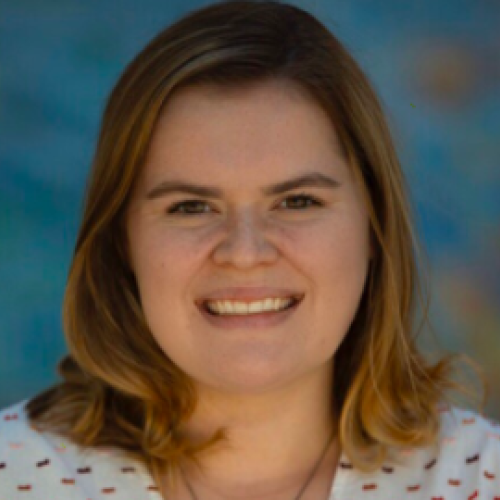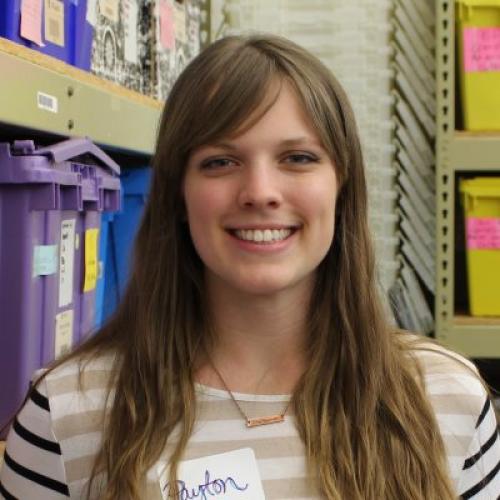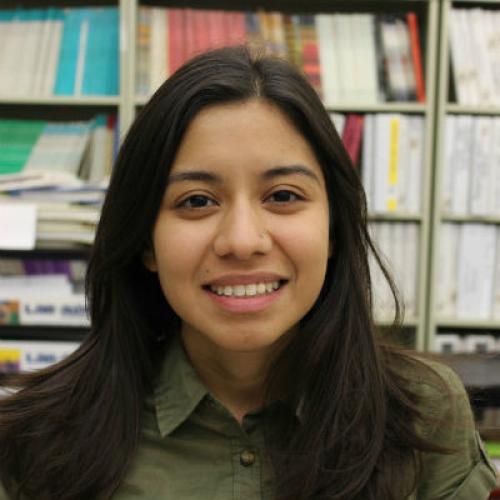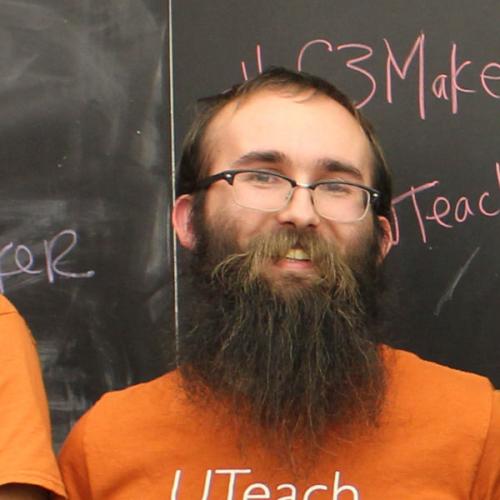Maker Fellows and Showcase Examples
A Maker Showcase is an open portfolio created by Makers to document and archive their experiences. This portfolio serves as a repository of work to show to the larger community including future employers. The goal of this Showcase is for students to create a personal expression of their maker journey that can be shared with others.
Click on the Maker Fellow to see their Maker Showcase.
-

Phillips Adebayo
Chemistry, Noyce Scholar -Fall 2019
Making to me means giving students the creative freedom to demonstrate their knowledge. The most essential part is that these maker projects are personalized, meaning students will be more willing to learn and work through obstacles to reach their final goal.
-

Kyle Albernaz
Chemistry - Fall 2017
Noyce Scholar
The maker movement has shown me that I can have meaningful learning experiences in logical subjects while also feeling fulfilled in my creative side. To me, making means bridging the gap between different types of people to foster a new community of learning.
-

Caroline Anderson
Chemistry - Spring 2019
Noyce Scholar
Many typical public school classrooms tend to follow a curriculum that lacks hands-on aspect to learning. Making in education is combating that style of teaching by providing students with the ability to learn by doing.
-

Paige Arneson
Biology - Spring 2017
Making in education is about empowering. Making provides students with an opportunity to take ownership and make a product they are proud of, with the potential of interweaving multiple disciplines. Making allows students to think critically and problem solve.
-

Niaz Azeez
Degree Holder - Fall 2019
Noyce Scholar
Making to me means the ability to make physical touch-and-feel versions of anything I can imagine or visualize. It gives incredible power and freedom to make anything without being limited by what is already available commercially.
-

Abdulkarim Bora
Physics - Fall 2017
Noyce Scholar
Making means bringing your imagination to life. We tend to underestimate ourselves and what we can accomplish, but if we put together our minds and are willing to learn new skills, we can go from being novices to experts.
-

Derek Casares
Physics - Fall 2019
While it's great to learn problem-solving from word problems, Making can allow an entirely different path that allows students to see that they do have the capability to use their knowledge to solve problems.
-

Payton Crawley
Mathematics - Spring 2018
I believe that making is the primary purpose of education, so by including making in a curriculum, students can explore more ways to solve the problems they see in their world. By being good makers, students are also learning how to thrive in society. They learn to find creative ways to innovate, and they can learn to do so as a group working together.
-

Connor Dillon
Mathematics - Fall 2020
Making is a mindset acknowledging that failure and mistakes are okay because failure is just a step toward success. In my classroom, I hope to instill this willingness to persist in the face of hardship in my students so that they realize that they can overcome any challenges they may face.
-

Ben Duong
Mathematics - Spring 2019
Noyce Scholar
Making is a tool that gets me excited about innovation, and testing something new. It has no limits on whom it can inspire, and what we can do with it. It's an activity that failure is accepted and encouraged because it helps you as a person. It is not stuck with one group, age, or gender, but it something that everyone can do
-

Krystal Evans
Mathematics - Spring 2018
Making gives students ownership over their learning. It is the best expression of creativity and creative thinking, and is a release for your inner need to manifest your thoughts and ideas. It gives a purpose for learning
-

Jean Feeser
Astronomy - Spring 2022
Making provides students the opportunity to learn in a meaningful way. I frequently hear students ask these questions: "Why are we doing this?", "How am I going to use this?", "Am I doing this right?". Maker Education provides those answers for students.
-

Cassandra Gonzalez
Public Health
The purpose of Making in education is to steer away from conventional ways of learning and put the process of discovery in the hands of the students, regardless of their background, who are offered the resources and opportunities to create, build, and produce.
-

Mirna Gonzalez
Chemistry - Fall 2017
Noyce Scholar
Making means innovation. People can try new things while they are making something and in the process they could improve on a preexisting invention, or create something new altogether. There is also no right or wrong in this process so there is the freedom to try anything.
-

Juliet Goodfellow
Mathematics - Fall 2021
Noyce Scholar
Making is a way for students to discover things for themselves, or see how something works by a physical model rather than through a verbal lecture. It is what I think leads students to visualize the most important things about each objective learned.
-

Amy Gross
Curriculum and Instruction - Fall 2017
Making is a way to bring knowledge to life, engage students, and create meaningful experiences. Making represents creativity in teaching and learning and it creates a novel experience that forces students to be present and active in class. Making can create pride in one's work with the potential to have a tangible product that students can walk away with.
-

Halle Herzog
Mathematics - Spring 2019
I feel Making is the future of education. Currently our education system is disadvantageous to students who do not learn well in the traditional way. Adding Making into education allows those students other ways to learn and show what they have learned. Making also builds confidence in students.
-

Christine Hui
Degree Holder - Spring 2022
Hands-on experience and a full understanding of the manufacturing process are important for innovators to create a viable design. With that experience, the students can think and plan more broadly and acquire knowledge that is not in the books.
-

John Langdon
Degree Holder - Fall 2017
Making is about making technology work in the real world; turning ideas into prototypes, then making prototypes work better. It gives students practical confidence and hands-on experience with trial and error success - the key element of engineering.
-

Mao Leonard
Mathematics - Spring 2019
Noyce Scholar
Making is a way for people to showcase their personalities and individualism. No two people are exactly alike. For example, one person may only see a piece of wood for what it is, but another may see it as a material for a wooden sculpture. People want to show the world what is important to them. They do this by creating something that they are proud of.
-

Kira Lowery
Biology - Spring 2018
Making is a way to solve problems through creation. When practicing making you are able to improve your critical-thinking skills by engaging in a hands-on solving mechanism. Makers are able to approach any problem with the idea that it can be solved, it just takes a bit of creativity and tinkering.
-

Susan McLain
Degree Holder - Fall 2018
Noyce Scholar
I think that the purpose of Making in education is to foster a really important growth mindset in students. They won't make their project perfectly the first time, but they can keep improving, learning, and gaining confidence.
-

Charlene Mitchell
Biology - Fall 2021
I see making as a way to step away from black and white and step into a world of color and creativity. I see making as creating something out of nothing; a way to materialize an idea and make it real.
-

Aminadab Morales
Physics - Fall 2017
To me, making is a revolutionary tool that can be used to supplement so much of the knowledge we teach our students. It is a way to apply the in-class knowledge to something you can put your hands on.
-

Garrett Mott - Fall 2020
Physics
Noyce Scholar
Making is an educational tool used to engage students’ minds and imaginations. This hands-on approach will let students push the boundaries of their imaginations and knowledge. Making breaks through the barrier between the classroom and the real world.
-

Shirley Nguyen
Mathematics
Making is the freedom to create or design something however you want to. The choice to make something through specific instructions or your own experiences and intuition is completely yours to decide.
-

Sofia Piperno
Degree Holder - Spring 2022
I firmly believe that making should be a priority. I have seen firsthand the effects that making has on students - they become more excited about learning, learn from each other, and retain what they have learned.
-

Ayesha Qadri
Biology - Spring 2018
Making is practicing and building upon your knowledge by taking your curiosity a step further and reinforcing it into something tangible. Making is what humans can do best, and that is the legacy we leave behind.
-

Miriam Reyes
Biology - Spring 2017
Making is anything that involves hands on creation, whether it be digital or physical. The purpose is to encourage the application of knowledge, as well as to get students' minds stimulated and working on solving problems.
-

Arami Roasles
Physics - Spring 2019
Noyce Scholar
The purpose of integrating Making into the classroom is to show students, who might otherwise not have access to Making, that STEM is exciting and engaging. Maker education is amazing because it allows students to be creative and use all of their passions to solve problems.
-

Maisha Rumman
Biology - Fall 2018
To me, making means being able to embrace this uncertainty by using creativity, play, and dedication to come up with a product. Making means being able to ask “why” --”why didn’t this work? What can I do to fix it?”
-

Kristiane Smith
Biology - Spring 2021
Making means to me the ability to have students use their strengths to explore and discover that they can accomplish new things. Making means asking why and how things work and discovering different answers to these questions.
-

Hannah Spock
Biochemistry - Spring 2017
Making is a great cross-curricular tool which relies on many skills, depending on the project. My favorite aspect is the potential for creativity and artistic expression, followed closely by the need for incorporation of "shop" skills and technology.
-

Gwen Udy
Mathematics - Spring 2022
Noyce Scholar
Making encourages students to be deeply engaged in both the content and their own learning processes. Making allows for the integration and expression of individuality through the creation of a product. Students are able to tell their stories through their own understanding and application of technology and content material. By allowing students to tailor their products and creations according to their own experiences, interests, and challenges, students are given greater control over their education.
-

Blaze Utz
Physics - Fall 2018
Making and the DIY movement as a whole represents the ability for regular people with no official technical expertise to build and modify devices to suit their specific needs. It also connects them to a large and growing, yet personal and close-knit community of people just like them, from whom they can learn and grow.

